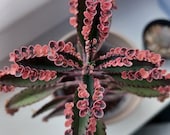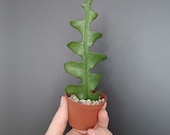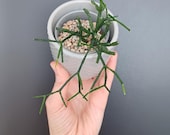
Are Zebra Plants Toxic to Cats?

Are zebra plants toxic to cats? The good news is, no! According to the ASPCA and NC State Extension, Zebra Haworthia (Haworthiopsis attenuata) is not on the list of plants toxic to cats. But your concerns are valid. After all, it sets any plant parent on edge if they catch their cat chewing a leaf. Additionally, zebra plants resemble the toxic aloe vera plant, which is definately not a cat-friendly plant.
Table of Contents
- What Is a Zebra Plant? (Quick ID for Cat Parents)
- Are Zebra Plants Toxic to Cats?
- Symptoms if Your Cat Chews a Zebra Plant
- What To Do If Your Cat Eats a Zebra Plant
- The Real Risk: Toxic Houseplants That Look Similar
- How To Cat-Proof Your Zebra Plant
- Related Toxic Plants Every Cat Parent Should Know
- Cat-Safe Plants That Pair Well With Zebra Haworthia
- Zebra Plants and Cats: FAQs
That’s where things get tricky. Safe doesn’t always mean symptom-free, and curious cats don’t read plant tags. Also, one reader on Reddit shared that their furry feline friend devoured half of the plant’s leaves within 15 minutes of bringing it home. But they were discussing another non-toxic plant, Aphelandra squarrosa, also called the Zebra plant.
In this guide, I’ll walk you through how to tell Haworthia Zebra apart from toxic lookalikes, what mild signs to watch for if your cat does chew a leaf, and which plants really deserve your worry.
What Is a Zebra Plant? (Quick ID for Cat Parents)
Zebra plants (Haworthiopsis attenuata and Haworthia fasciata) are those tidy little succulents you see on windowsills everywhere.
They’re characterized by dark green rosettes striped with white, bumpy bands. It’s an instant plant for beginners, thrives in bright indirect light, and is safe for cats. The problem? Its name gets tangled up with Aloe and Aphelandra, both of which have very different plant safety ratings.

Are you looking for more ideas on keeping cats safe around houseplants? Check out our comprehensive guide to keeping cats safe around plants.
Haworthia vs. Aloe vera
At first glance, Zebra Haworthia can trick you into thinking it’s aloe. Aloe leaves are thicker, filled with gel, and—here’s the kicker—aloe is a toxic plant for cats. Haworthia stays compact, clumps neatly, and its raised white tubercles make it easy to spot once you know the difference.
Haworthia vs. Aphelandra
Then there’s Aphelandra squarrosa, another “zebra plant.” Totally different type of plant in terms of growth habits and leaf shape. It has broad, glossy leaves with sharp white veins and flashy yellow blooms. It’s not a succulent at all, and while it’s usually listed as non-toxic and pet safe, it doesn’t overlap with Haworthia beyond the confusing nickname.
Are Zebra Plants Toxic to Cats?
The good news is that Haworthia Zebra isn’t on the ASPCA list of plants toxic to cats. It’s also classified as a non-toxic plant for dogs. This is a relief for plant parents who have noticed nibbles on the succulent leaves of their plants. You can safely place zebra plants alongside other cat-friendly plants, such as spider plants and African violets.
The difference between zebra plants and toxic cat plants is that they do not contain saponins and other toxic compounds.
Think of saponins as plant soap—they foam up in a cat’s digestive system, irritate the stomach lining, and trigger a cascade of problems. Zebra haworthia doesn’t make those compounds. No saponins, no hidden toxins. That’s the simple chemical difference between a safe plant and one that lands you in a late-night vet call.
Symptoms if Your Cat Chews a Zebra Plant
If your cat nibbles Zebra Haworthia, you can usually relax. This succulent is safe for cats, so you won’t see toxic reactions. At worst, expect a little drool or a one-time puke—more about fibrous leaves than poisoning. In fact, the biggest casualty is probably the plant.
One Reddit user shared that their cat ate half of a zebra plant within minutes. The cat was unharmed, but the plant was left in poor shape—an example of how the risk is mainly cosmetic for the plant.
Shopt for plant-safe succulents from my shop
Now, compare that to toxic plants. Aloe, snake plants, and ZZ are loaded with saponins and other irritants. Cats who chew those often face repeated vomiting, diarrhea, tremors, or that drained, glassy-eyed look every pet parent dreads.
So when do you actually worry? If the symptoms persist beyond mild stomach upset—such as persistent vomiting, diarrhea, or weakness—that points to a toxic plant, not zebra haworthia. That’s your cue to call the vet fast.
How do you know if your feline buddy has got snake plant poisoning? Check out my guide to the tell-tale signs your cat has licked a snake plant.
What To Do If Your Cat Eats a Zebra Plant
First off, don’t panic. Zebra haworthia is safe, so your cat isn’t in danger. What usually happens? You’re left with a half-chewed succulent that looks like it’s been through a lawn mower, while your cat trots away completely unfazed.

Still, it’s smart to give things a quick check. Wipe any leaf bits from your cat’s mouth and clear the mess around the pot. Keep an eye on your pet for the next day or so. If all you notice is a little drool or a one-time puke, that’s just irritation from chewing, not poisoning.
The only time to worry is when the symptoms don’t align. Repeated vomiting, diarrhea, or sudden lethargy aren’t caused by zebra haworthia. Those are red flags for cat-toxic plants like snake plants or aloe. If you see them, it’s time to call the vet—because your cat has probably found something more dangerous to chew.
The Real Risk: Toxic Houseplants That Look Similar
Here’s where the confusion really happens. Zebra haworthia looks a lot like aloe vera plants—toxic for cate. At a glance, even some seasoned plant parents mix them up. The catch? Aloe is on the ASPCA’s toxic plants cats list, while zebra haworthia is completely safe.
Snake plants also add to the mix too. Those stiff, sword-like leaves also contain saponins, which can leave your cat vomiting and weak if chewed. ZZ plants fall into the same camp. They’re stylish, but absolutely not cat-friendly. That’s why zebra plants aren’t a good mix with snake plants and ZZ plant in a car-friendly indoor plant garden.
While you don’t need to stress about zebra haworthia, you do want to keep an eye out for the dangerous lookalikes. If your cat is showing real signs of poisoning, chances are they’ve found one of these toxic houseplants instead.
How To Cat-Proof Your Zebra Plant
Here’s the thing with zebra plants and toxicity to cats: it’s the plant that needs protecting, not your four-legged furry friend. Zebra plants—Horworthia fasciata or Aphelandra squarrosa to totally safe with pets in the house.
But here’s the thing that plant parents will tell you: Those neat striped rosettes can end up chewed down to nubs if you don’t get creative. Here are a few tricks plant parents swear by:
- Placement: High shelves, hanging planters, or glass terrariums keep plants out of reach. Cats love to climb, but they rarely bother with enclosed displays.
- Distraction: Offer cat grass or catnip nearby. Many owners say their cats leave houseplants alone once they have a safe snack.
- Deterrents: Citrus peels, double-sided sticky tape, or motion-sensor sprays make pots less inviting.
- Routine: Rotate plants to sunny spots where cats spend less time. Sometimes simply changing the environment does the trick.
Zebra haworthia may not poison your cat, but saving those striped leaves from tiny teeth is worth the effort.
Related Toxic Plants to Cat Every Plant Parent Should Know
Zebra haworthia might be safe, but plenty of lookalikes and common houseplants aren’t. These are the ones that show up again and again on the ASPCA’s toxic plants for cats list:
- Aloe vera: Gel-filled leaves that soothe humans but cause vomiting and diarrhea in cats.
- Snake plant: Stylish, upright leaves loaded with saponins—bad news for pets.
- ZZ plant: Popular in offices, but toxic if chewed.
- Jade plant: A classic succulent that’s anything but cat-friendly.
- Pothos (Devil’s Ivy): Trails beautifully, but irritates the mouth and gut.
These are the plants to keep out of reach—or better yet, out of the house entirely if you’ve got cats. If your pet ever shows the red-flag symptoms of poisoning, it’s far more likely they’ve gotten into one of these, not your zebra haworthia.
Cat-Safe Plants That Pair Well With Zebra Haworthia
If you love the bold stripes of zebra haworthia but want more variety, good news—there are plenty of cat-friendly plants you can grow alongside it. These non-toxic choices also appear on the ASPCA’s list of safe products, so your collection looks lush without the worry.

- Spider Plant (Chlorophytum comosum): Easy to grow, arching leaves, and totally safe. Cats often find them fun to bat at.
- African Violet (Saintpaulia): Soft, fuzzy leaves and colorful blooms that brighten shelves.
- Baby Rubber Plant (Peperomia obtusifolia): Glossy foliage, compact size, and pet-safe credentials.
- Prayer Plant (Maranta leuconeura): Striking patterned leaves that fold at night—safe and showy.
- Cast-Iron Plant (Aspidistra elatior): Hardy, dark green foliage that tolerates low light.
- Air Plants (Tillandsia): Minimal care, no soil required, and safe around curious paws.
- Aluminum Plant (Pilea cadierei): Shiny silver markings that pop next to zebra stripes.
Want plants that look this good without the worry? Explore my handpicked collection of succulents and cat-safe plants in the shop. Build a green space that’s stylish, pet-friendly, and totally stress-free.
Mixing zebra haworthia with these plants creates a cat-friendly collection that looks great and stays worry-free. No toxic compounds, no late-night vet calls—just a thriving indoor jungle.
Zebra Plants and Cats: FAQs
Is Zebra Haworthia toxic to cats?
No. According to the ASPCA, Zebra Haworthia (Haworthiopsis attenuata) is non-toxic to cats, dogs, and even horses. It’s one of the few succulents you can keep without worry.
Why does my cat vomit after eating a “safe” plant?
Even safe plants can irritate a cat’s stomach. Chewing fibrous leaves often leads to a quick puke or drooling—that’s irritation, not poisoning. If vomiting repeats, check for toxic plants nearby and call your vet.
How can I tell Zebra Haworthia from aloe vera?
Zebra haworthia grows in tight rosettes with white raised stripes. Aloe leaves are thicker, filled with gel, and lined with teeth. Aloe is on the ASPCA’s toxic plants for cats list—haworthia isn’t.
Is Aphelandra squarrosa (another “zebra plant”) safe for cats?
Yes, Aphelandra squarrosa is also considered non-toxic. But it’s completely different from haworthia—it has broad glossy leaves with white veins and yellow flowers, not succulent rosettes.
What should I do if my cat eats a zebra plant?
Stay calm. Clean up the chewed leaves, wipe your cat’s mouth if needed, and watch for mild signs of plant ingestion like drooling. Persistent vomiting, diarrhea, or weakness usually point to toxic plants like aloe or snake plant—call your vet if you see these.
How can I protect my zebra haworthia from cats?
Place it on shelves, in terrariums, or use deterrents like citrus peels and sticky tape. Offering cat grass nearby works too—it saves your safe plants from curious teeth.
What cat-safe plants look good with zebra haworthia?
Spider Plant, African Violet, Baby Rubber Plant, Prayer Plant, Cast-Iron Plant, Air Plants, and Aluminum Plant all pair beautifully—and they’re non-toxic. You can browse safe houseplants for cats in our shop to start your collection.



